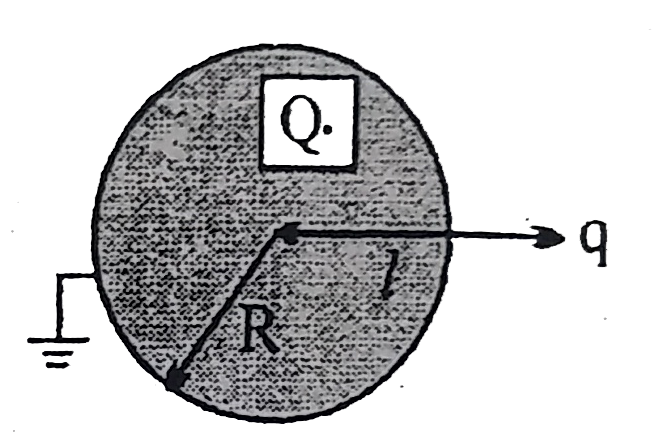A negative charge is placed at the centre of the non-conducting sphere. The direction of electric field on any point at the surface of the sphere is
radially inward
radially outward
along the tangent to the surface
no electric field produced
The correct Answer is:A
When a negative charge is placed at the centre of the non-conducting sphere. The direction of electric field on any point at the surface of the sphere is radially inward, as shown in the figure. because electric field lines always enter into the negative charge comming from Infinity.

Topper's Solved these Questions
Similar Questions
A charge q is placed st the centre of a spher. Taking outward normal as positive, find the flux of the electric field through the surface of the sphere due to the enclosed charge.
View SolutionA charge q is placed st the centre of a spher. Taking outward normal as positive, find the flux of the electric field through the surface of the sphere due to the enclosed charge.
View Solution
Knowledge Check
There is a cubical cavity inside a conducting sphere of radius R. A positive point charge Q is placed at the centre of the cube and another positive charge q is placed at a distance 1(>R) from the centre of the sphere. The sphere is earthed

Net charge on the outer surface of conducting sphere isA+QBQ−qR/1C−qR/IDnoneSTATEMENT -1: A point charge q is placed in front of a solid conducting sphere. Electric field due to induced charges at the centre of sphere is zero .
 .
.
STATEMNT -2 : Electric field at a point inside the solid body fo conductor is zero.AStatement -1 is True , Statement -2 is True ,
Statement -2 is a correct explanation for
Statement -9BStatement -1 is Tre , Statement -2 is True ,
Statement -2 is NOT a correct explanation for statement -1.CStatement -1 true, Statement -2 is False.DStatement -1 is False , Statement -2 is true.Given below are two statements :
Statement I : An electric dipole is placed at the centre of a hollow sphere. The flux of electric field through the sphere is zero but the electric field is not zero anywhere in the sphere.
Statement II : If R is the radius of a solid metallic sphere and Q be the total charge on it. The electric field at any point on the spherical surface of radius r(<R) is zero but the electric flux passing through this closed spherical surface of radius r is not zero.
In the light of the above statements, choose the correct answer from the options given below :ABoth Statement I and Statement II are trueBStatement I is true but Statement II is falseCBoth Statement I and Statement II are falseDStatement I is false but Statement II is true.
A charge q is placed at the centre of an imaginary spherical surface. What will be the electric flux due to this charge through any half of the sphere.
View SolutionThe electric field due to a point charge at a distance R from it is E. If the same charge is placed on a metallic sphere of radius R, the electric field on the surface of the sphere will be nE, then the value of n is
View SolutionA solid conducting sphere of radius r is having a charge of Q and point charge q is a distance d from the centre of sphere as shown. The electric potential at the centre of the solid sphere is :

View SolutionA solid conducting sphere of radius r is having a charge of Q and point charge q is a distance d from the centre of sphere as shown. The electric potential at the centre of the solid sphere is :

View SolutionThe electric field due to point charged at a distance R form it is E. if the same charge is placed on a metallic sphere of Radius R, the electric field on the surface of the sphere will be
View Solution
